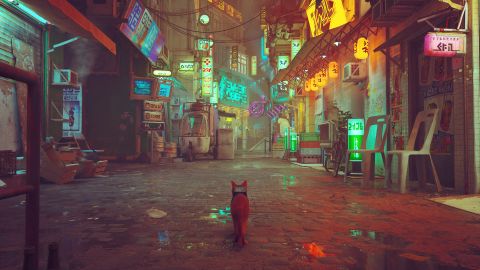Our Verdict
Simple, polished systems allow Stray's rich fiction and charismatic star to shine.
PC Gamer's got your back
What is it? A post-apocalyptic puzzle-platform adventure starring a resourceful moggy.
Expect to pay: £24.99/$29.99
Release date: July 19, 2022
Developer: Blue Twelve Studio
Publisher: Annapurna Interactive
Reviewed on: RTX 2070, i7-10750H, 16GB RAM
Multiplayer? No
Link: Official site
The early novelty of playing as a cat in Stray soon gives way to a striking realisation—we often behave like cats in games anyway. Particularly in platform-puzzlers like this, our first inclination is to explore, looking for unorthodox routes up the sides of buildings, say, or jumping on furniture and seeing which objects we can manipulate. Stray simply makes such activities more natural, giving us the perfect form for the job.
The feel of your moggy is crucial here, and it's instantly evident how much observational work has gone into her animation. The slender ginger tabby is one of a small feline colony living in a disused industrial district long since reclaimed by nature. As the game opens, your gang waits out a storm in a concrete shelter, where you can instigate a little play fighting or mutual sniffing and smearing. These interactions are full of recognisable details—the way ears flick and rotate, the stretch routines—and if you like cats (as I do), Stray should have you at "meow".
Next morning you venture out with your crew, leaves still dripping from last night's downpour. You might pause to lap at pools of water, or employ a tree trunk as a handy scratch post, in between bouts of leaping up steps and across gaps. At first it seems overly prescriptive that you can only jump when a button prompt appears on a nearby ledge, box or pipe, with a successful landing guaranteed. Yet this system is ideally suited to the litheness of an animal with measured aims, who cares not for frantic hopping but scans the environment for clearly reachable surfaces. And while there are points when Stray abuses its control by refusing to let you jump on barrels and boxes merely because they aren't part of the essential path, the overall result is a slick, satisfying loop of pause, look, leap that sustains the feline illusion.
Nasty piece of zurk
Indeed, the prowl and pounce rhythm introduced in the opening minutes could have kept me entertained for some while on its own. As it happens, though, the plot soon intervenes: a rusty pipe betrays our sure-footed avatar as she vaults a chasm, snapping under her weight to send her tumbling down then down some more into darkness. She's now stuck in much less idyllic surroundings—dusty, garbage-ridden ruins. Look up and you see a distant halo of light, from which mournful meows echo down. From such innocent beginnings, it's a gut punch. I don't recall the last time I cared about a game protagonist's fate so much.
What follows for the rest of the game is a journey to reach the top again, revealing the fate and legacy of an extinct humanity on the way. It seems that people built the underground city you've plummeted into because the planet surface had grown toxic, only to meet their ends regardless, long before the outside bloomed once again. All that remains are their former android servants, functioning free from direction, and hordes of nasty beasties called zurks, which look like baby headcrabs from Half-life and exist merely to chew through anything that moves.
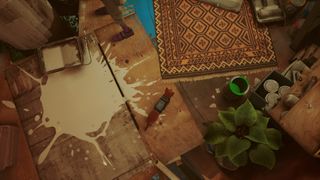
At various stages of your adventure, you'll have to pass through zurk-infested territory, usually marked by a coating of unsightly, stringy goo, as if a giant pizza had exploded. At first, the only way to survive the zurks is to run for your life, sprinting into the screen while plotting paths between streams of the squeaky blobs and weaving at speed to avoid their grasps. Later, you'll find them blocking your route and have to trick them into chasing you with taunting meows—a reverse game of cat and mouse—to lead them astray. None of this is especially taxing, however, and while it's certainly possible to get caught, these sections mainly serve to vary the pace between more unhurried travails.
Dream machines
You'll also soon find a friend to give you some technological guidance. Hopping along the city's concrete peaks, watched by surveillance cameras, a series of neon signs seems to be directing you somewhere specific. Follow the path and you meet an AI called B-12 who wants to join you in returning to the great outdoors. It uploads itself into a tiny drone and 3D-prints a harness around the cat in which to house itself. B-12 is now your partner, the mouth and hands you'll need to converse with robots, hack doors, and store puzzle-solving items—crucial in a concrete and metal conurbation where nobody thought to install cat flaps.
You'll rely on your buddy most once you reach a little oasis in amongst the mess where robots have made their home. This place thrums with life, even though there's none, with haphazard streets framed by neon signs that neatly reverse edgy cyberpunk connotations, bringing a healthy glow to an enclave robbed of sunlight. Stray now gives you space to play again, as B-12 helps you seek information from the androids and aid them in return. A barter bot will trade useful bric-a-brac for energy drinks, for example, while a guitarist wants you to seek out music sheets so she can play some songs.
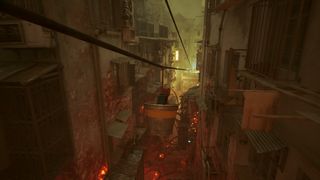
These androids aren't merely quest givers—they're an essential supporting cast. It's fascinating to see how the human-built machines have picked up on fragments of their makers' dead culture. They don items of human clothing, displaying facial expressions on monitor heads crowned by hair made from nests of wires—a fashion consciousness born of half-understood mimicry that nonetheless feels authentic because it wasn't socially programmed. At the same time, they have no frame of reference when it comes to meeting a cat, thus standing idly as you jump on their tables, knocking over their cups. In other words, they're like every minor RPG NPC you've ever met, except here they make sense.
Moggy style
It's also when you start criss-crossing this populated settlement and its interiors—jumping on a bar next to a collapsed drinker, or between bookshelves in a researcher's lab—that the solidity of Stray's scenery comes to the fore. 3D game worlds are often an awkward combination of items that don't budge and others that fly or break at the slightest touch, but from the perspective of a cat that's how things work. Most things are too heavy to disrupt, except those empty bottles you can scatter, or the pile of books you jump on, then send teetering to collapse as you propel yourself off again. And despite occasional visual anomalies, such as clipping or brief animation glitches, Stray creates a believable logic to the way your fun-sized tiger navigates spaces.
Because of that, indulging your sense of kitty mischief and inquisitiveness becomes especially enticing. Wheelie bins and air-con units offer quick vertical ascension, and once you're up on the roof, can you resist pawing a paint can off a ledge? Or at ground level, how about entering a home and pulling down the curtains, or scratching the rugs? That's always fun. Yet rather than gratuitous, causing minor chaos seems like a side effect of natural curiosity, traversing a world that isn't built for your instincts. You aren't clumsily smashing the place up, you're expressing yourself, strongly encouraged by the game design.
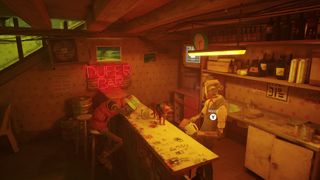
For the rest of its duration, Stray continues to oscillate between playfulness and danger. As your determined cat gradually rises towards the surface again, you make new robot friends, helping them to reach their goals, get into tighter scrapes, and learn more about the history of this buried city in its richly detailed ruins. Throughout the 6-8-hour run time, the objectives remain clear and simple, leaving you plenty of space to enjoy the worldbuilding and simply being a cat.
Cool for cats
To a degree, this simplicity is a weakness, in that it feels as if there's room for Stray to stretch its systems and your skills a bit more, adding urgency to sequences of jumps, perhaps, or extra complexity to its puzzles. Because it doesn't, a few sequences get stuck in low gear, such as when you get to fight back against the zurks, a confrontation that boils down to repeated backpedalling and shooting (and places the bland digital abilities of B-12 at centre stage, rather than our fluffy hero's), or don't evolve enough to escape the sense that they lack originality, serving up tasks that follow well-rehearsed genre lines.
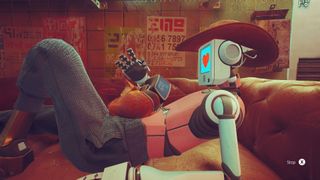
Still, Stray compensates for such lapses by ensuring each idea makes room for the next before it leaves a stain, acting as merely one part of an ensemble. But more than that, it remains a revelation precisely because it takes familiar adventure game tropes and makes them purr with smoother, cleaner mechanics. Rather than provide a roughly approximated simulation of people interacting with people, it builds fleeting but impactful relationships of mutual reliance between cat and robot. Stray's commitment to this premise, packed with the nuances of both feline and android life, is a triumph.
Throughout, playing a cat never stops being a joy. Perhaps the biggest endorsement I can give Stray is that even some defenceless stealth sequences in its final third are not only tolerable, but actually entertaining—surely a first. Like so much in the game, the character makes them work. What it lacks in complexity, then, it more than makes up for with agility and adaptability. If only more games had such sharp instincts.
Simple, polished systems allow Stray's rich fiction and charismatic star to shine.

Kentucky Route Zero and Stray publisher Annapurna Interactive has collapsed, with its entire staff quitting en masse

While other companies do expensive crossovers with Fortnite, Renault's been modding its little electric car into Garry's Mod, Palworld and Stardew Valley—and the mods actually look good
